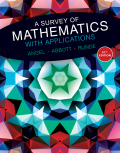
Concept explainers
Pick any number and add 10 to the number. Divide the sum by 5. Multiply the quotient by 5. Subtract 10 from the product. Then subtract your original number.
a. What is the result?
b. Arbitrarily select some different numbers and repeat the process, recording number and the result.
c. Can you make a conjecture regarding the result when this process is followed?
d. Prove, using deductive reasoning, the conjecture you made in part (c).
Want to see the full answer?
Check out a sample textbook solution
Chapter 1 Solutions
A Survey of Mathematics with Applications (10th Edition) - Standalone book
Additional Math Textbook Solutions
Graphical Approach To College Algebra
Precalculus: Mathematics for Calculus (Standalone Book)
Pathways To Math Literacy (looseleaf)
Probability And Statistical Inference (10th Edition)
Precalculus
University Calculus: Early Transcendentals (4th Edition)
- Answer question S8 stepwisearrow_forwardAnswer questions 8.2.11 and 8.2.12 respectivelyarrow_forward8.4.2 An article in Knee Surgery, Sports Traumatology, Arthroscopy [“Arthroscopic Meniscal Repair with an Absorbable Screw: Results and Surgical Technique” (2005, Vol. 13, pp. 273–279)] showed that only 25 out of 37 tears (67.6%) located between 3 and 6 mm from the meniscus rim were healed. a. Calculate a two-sided 95% confidence interval on the proportion of such tears that will heal. b. Calculate a 95% lower confidence bound on the proportion of such tears that will heal. 8.4.3 An article in the Journal of the American Statistical Association [“Illustration of Bayesian Inference in Normal Data Models Using Gibbs Sampling” (1990, Vol. 85, pp. 972–985)] measured the weight of 30 rats under experiment controls. Suppose that 12 were underweight rats. a. Calculate a 95% two-sided confidence interval on the true proportion of rats that would show underweight from the experiment. b. Using the point estimate of p obtained from the preliminary sample, what sample size is needed to be 95%…arrow_forward
- 8.4.8 Use the data from Exercise 8.4.2 to compute the two-sided Agresti-Coull CI on the proportion of tears that heal. Compare and discuss the relationship of this interval to the one computed in Exercise 8.4.2.arrow_forwardAnswer questions 8.3.7 and 8.4.1 respectivelyarrow_forwardDon't do 14. Please solve 19arrow_forward
- 8.4.7 Use the data from Exercise 8.4.5 to compute the two-sided Agresti-Coull CI on the proportion of digits read correctly. Compare and discuss the relationship of this interval to the one computed in Exercise 8.4.5.arrow_forward8.6.5 Consider the fuel rod enrichment data described in Exercise 8.2.11. Compute a 90% prediction interval on the enrichment of the next rod tested. Compare the length of the prediction interval with the length of the 99% CI on the population mean.arrow_forward8.4.4 The Arizona Department of Transportation wishes to survey state residents to determine what proportion of the population would like to increase statewide highway speed limits from 65 mph to 75 mph. How many residents does the department need to survey if it wants to be at least 99% confident that the sample proportion is within 0.05 of the true proportion? 8.4.5 The U.S. Postal Service (USPS) has used optical character recognition (OCR) since the mid-1960s. In 1983, USPS began deploying the technology to major post offices throughout the country (www.britannica.com). Suppose that in a random sample of 500 handwritten zip code digits, 466 were read correctly. a. Construct a 95% confidence interval for the true proportion of correct digits that can be automatically read. b. What sample size is needed to reduce the margin of error to 1%? c. How would the answer to part (b) change if you had to assume that the machine read only one-half of the digits correctly?arrow_forward
 Holt Mcdougal Larson Pre-algebra: Student Edition...AlgebraISBN:9780547587776Author:HOLT MCDOUGALPublisher:HOLT MCDOUGAL
Holt Mcdougal Larson Pre-algebra: Student Edition...AlgebraISBN:9780547587776Author:HOLT MCDOUGALPublisher:HOLT MCDOUGAL Algebra: Structure And Method, Book 1AlgebraISBN:9780395977224Author:Richard G. Brown, Mary P. Dolciani, Robert H. Sorgenfrey, William L. ColePublisher:McDougal LittellAlgebra & Trigonometry with Analytic GeometryAlgebraISBN:9781133382119Author:SwokowskiPublisher:Cengage
Algebra: Structure And Method, Book 1AlgebraISBN:9780395977224Author:Richard G. Brown, Mary P. Dolciani, Robert H. Sorgenfrey, William L. ColePublisher:McDougal LittellAlgebra & Trigonometry with Analytic GeometryAlgebraISBN:9781133382119Author:SwokowskiPublisher:Cengage College Algebra (MindTap Course List)AlgebraISBN:9781305652231Author:R. David Gustafson, Jeff HughesPublisher:Cengage Learning
College Algebra (MindTap Course List)AlgebraISBN:9781305652231Author:R. David Gustafson, Jeff HughesPublisher:Cengage Learning Glencoe Algebra 1, Student Edition, 9780079039897...AlgebraISBN:9780079039897Author:CarterPublisher:McGraw Hill
Glencoe Algebra 1, Student Edition, 9780079039897...AlgebraISBN:9780079039897Author:CarterPublisher:McGraw Hill Elementary AlgebraAlgebraISBN:9780998625713Author:Lynn Marecek, MaryAnne Anthony-SmithPublisher:OpenStax - Rice University
Elementary AlgebraAlgebraISBN:9780998625713Author:Lynn Marecek, MaryAnne Anthony-SmithPublisher:OpenStax - Rice University





